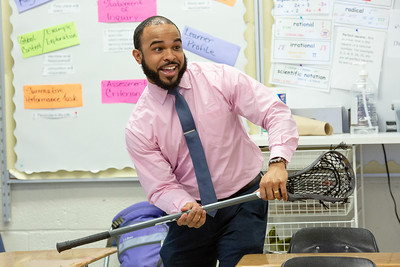Sign up for our daily edtech news briefing today, free.
The US is facing a STEM teacher shortage, with more than half of school districts across the country reporting they struggle to recruit and retain qualified STEM teachers. Proposed solutions run the gamut from reasonable suggestions to pay STEM teachers more to employing robots to teach our children.
While teachers certainly deserve better compensation, school budgets are already tight, leading to political battles that inevitably revert to the status quo. Though robots may fit right into a STEM class, they’re probably more properly relegated to objects of study rather than directors of it.
But what if the way we train and support teachers, particularly those of color and those who specifically want to work in underserved communities, is a big part of the problem?
Well, that’s much easier to fix.
Students need teachers, not content experts
In my undergraduate studies, I had three majors, all of them humanities. I started teaching by joining Teach for America, where I was sent into a STEM classroom. I panicked a bit and told them I hadn’t had a real science or math class in about five years, but they said, “No, no, it’s fine. You’ll be totally fine.”
They were right! By teaching middle-school math, science, technology and economics, I learned that “Teachers must be content experts” is one of education’s biggest fallacies.
For too long, we have been trying to recruit teachers from STEM professions, where people can get much more competitive salaries and may not love children and educating them. Students should be the reason teachers get up in the morning. Kids aren’t empty vessels, and teaching isn’t about filling them with knowledge. Teaching is a relational activity that requires familiarity and trust. If someone can’t build that with students, they can’t teach very well, no matter how much expertise they hold in the subject matter.
Filling vacancies in the science department by poaching teachers from other departments is another short-sighted fix that doesn’t much serve the needs of the students. We need to think bigger-picture and find better ways to change the ways we recruit and retain pre-service teachers.
Teacher candidates need less theory, more practice
Just like students, the way teachers get better is through practice and feedback. We know failure is a learning opportunity. We talk to students about having a growth mindset and encourage them to try things over and over until they get them right, looking for opportunities to improve with each attempt.
Yet, in teaching programs we so often seem to focus on theory. We ask teachers in training to write papers about the pedagogy they should employ to teach this or that. It may well demonstrate that they are smart people who can remember and explain abstract ideas about teaching, but does it make them good teachers who can apply those concepts within the messy context of the real world?
The theory underlying our understanding of effective pedagogy is important, but so is connecting with students. Kids need teachers who understand their cultures, the climate of their communities, the human side of education. We need more practical training for teachers and a greater focus on learning what people who are good at building relationships with students are doing differently.
We need differentiated training and coaching
It’s no secret that the teaching profession is overwhelmingly white and female. Federal data from 2020 found that 79.3% of public school teachers are white (down from 82% in 2011) and 76.5% are female. We know, however, that teachers of color can be more effective teachers for students of color and beneficial for white students, and one reason may be the focus on the relational piece of teaching in a way that generally is not emphasized among white women teachers (particularly for students of color).
Teaching can be really hard as a racial minority. The lower workforce numbers mean it can be more difficult to find a network within the school or district. Teachers of color also have to face an unconscionable number of microaggressions – and just plain aggressions – from school leaders, colleagues and parents.
We all come to the teaching profession with different strengths and weaknesses, but teacher training and coaching programs don’t offer much differentiation. Building in that differentiation would allow us to take an asset-based approach to teacher training, focusing on the strengths each individual brings to the table and preparing them for the challenges they are most likely to confront.
Ultimately, we should be taking the lessons from our STEM classrooms about the way students learn best and applying them to our teacher training programs. We need to differentiate, acknowledge that failing is learning, and accept that everyone has value and something to offer in the classroom.
Content is important, but kids will learn better if they have people in the classroom who care deeply about them and show them as much every day.
Christine Schepeler is the former director of math and science at the Charles Sposato School of Graduate Education and director of partnerships at STEM Ed Innovators, a nonprofit committed to democratizing STEM education. Reach out to her via email.
________________________________
If you liked this article, sign up for SmartBrief’s free email newsletter on EdTech. It’s among SmartBrief’s more than 250 industry-focused newsletters.
More from SmartBrief Education:
